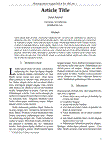| Sumario: | Shrimp is one of the most cultured crustacean worldwide due to its high protein and nutrient content. At the same time shrimp aquaculture faces a huge challenge in controlling disease outbreaks. The extensive use of antibiotics to combat the infectious organisms has led to the emergence of antibiotic resistance which is a huge threat to humans and other living forms. Therefore, a more environment friendly treatment strategy should be devised. One such treatment option is the use of biopolymers such as polyhydroxyalkanoates (PHAs). The most widely used PHA is the anti-infective poly-β-hydroxybutyrate which can be fermented into immune stimulating short chain fatty acids by host bacteria or digestive enzymes. PHB produced by marine microorganisms are widely studied and considered to be a good source of PHB for industrial use. PHB has been found to possess multiple benefits to shrimp health which includes immune stimulation, antibacterial properties, increased secretion of digestive enzymes and growth promotion. Moreover, PHB-diet positively influences the gut microbiome of shrimp, therefore, promoting the overall health and growth.
|
|---|
